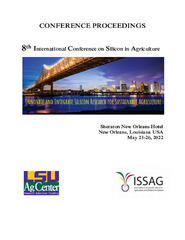| dc.description.abstract | Pedunculate oak (Quercus robur L.) is the most abundant deciduous tree species in Europe with high economical and ecological importance. Different species of Phytophthora are considered as one of the most important factors responsible for deterioration of oak forest, causing serious root damage not only in the forest trees, but also in the nurseries. Oak seedlings were grown in plastic pots with extremely low phosphorus (P) soil (1.5 mg kg-1 total P; no available Olsen-P detected). Silicon (Si) and P were supplied as Na2SiO3 (300 mg Si kg-1 dry soil) and KH2PO4 (180 mg P kg-1 dry soil), respectively. Four treatments (-P/-Si, -P+/Si, +P/-Si, and +P/+Si) were used in the experiment. After two months of experiment, a half of the plants in each treatment were root-inoculated with Phytophthora plurivora. After further four weeks, the first symptoms of P. plurivora infection appeared in leaves (e.g., leaf necrosis and wilting). Plants were then carefully removed from the pots, divided into roots and shoots, and the roots were scanned and analyzed by the WinRHIZO® software. Foliar concentrations of Si, P, K, Ca, Mg, B, Cu, Fe, Mn, and Zn were determined by ICP-OES, while the concentrations of N and S were determined by CHNS Analyzer. The addition of Si obviously improved root health status (e.g., decreasing de number of lesions and necrosis intensity) in the infected plants grown under -P conditions, which was followed by an increased foliar P concentration. The Si supply significantly increased the root variables (e.g., total root volume, root length, and area of thin roots) in both -P and +P plants inoculated with P. plurivora. Therefore, P. plurivora infection and supply of P and Si modulated the nutrient uptake and thereby changed the leaf ionomics, especially for infected -P plants supplied with Si (e.g., significantly increased B, Cu, and Si foliar concentrations and decreased Fe, Mn, Ca, Mg, K, and S foliar concentrations). Furthermore, Si fertilization significantly declined loses in plant dry biomass caused by P. plurivora infection and/or P deficiency, showing biomass comparable to non-infected +P plants. | sr |

